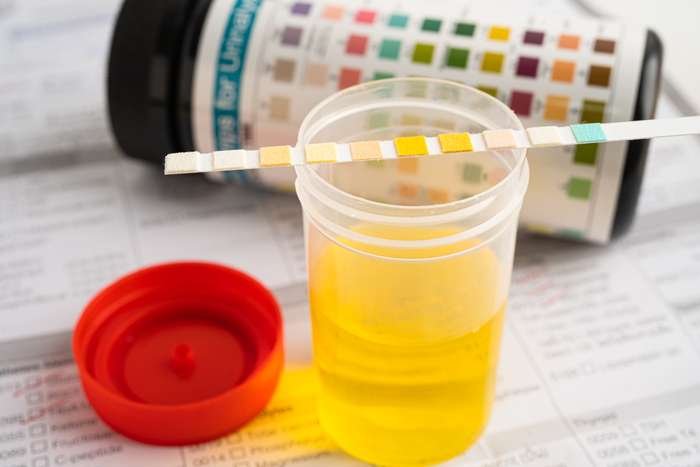
Ensure your health. Get tested today.
Convenient lab testing at your fingertips at more than 5,000 locations nationally. Consult with a doctor, or get tested on your own.

Glucose in urine, a condition known as glucosuria, can be indicative of underlying health issues, particularly diabetes mellitus. It delves into the symptoms associated with glycosuria, such as increased thirst and frequent urination, and highlights the importance of diagnostic testing to confirm the condition. This article examines the various causes of glucose in urine, ranging from uncontrolled diabetes to renal glycosuria, and discusses potential treatments and management strategies to address the underlying causes and maintain overall health.
In addition to outlining the clinical significance of glucose in urine, we will provide insights into lifestyle modifications and medical interventions that can help individuals manage their blood sugar levels effectively. By understanding the symptoms, testing methods, causes, and treatment options, the National Organization of Rare Diseases (NORD) notes that people can understand this condition and its implications to health and wellness.
Glycosuria refers to the presence of glucose in the urine, according to NORD. They explain that glycosuria is a condition that occurs when the kidneys filter excess glucose from the bloodstream and excrete it as waste. This phenomenon typically indicates that blood glucose levels are elevated beyond the renal threshold, which is the point at which the kidneys can no longer reabsorb all the glucose back into the bloodstream. Understanding glycosuria is essential for diagnosing and managing various medical conditions, particularly diabetes mellitus, as it can serve as an important indicator of metabolic health.
When glucose is present in urine, it can signal that the body is unable to effectively utilize or regulate blood sugar levels. In healthy individuals, the kidneys reabsorb glucose almost entirely, preventing its loss in urine. However, in cases of uncontrolled diabetes, hormonal imbalances, or certain kidney disorders, glucose spills into the urine, leading to symptoms such as increased urination and thirst. Monitoring glycosuria is crucial for individuals with diabetes, as it can provide insights into their glycemic control and overall health status, prompting necessary adjustments in treatment and lifestyle.

Convenient lab testing at your fingertips at more than 5,000 locations nationally. Consult with a doctor, or get tested on your own.
The presence of sugar in urine, known as glycosuria, can lead to various symptoms that indicate an underlying issue with blood sugar regulation, according to the Merck Manuals. They note that recognizing these symptoms is crucial for early intervention and management, especially for individuals at risk of diabetes or those already diagnosed with the condition. If you notice any of the following symptoms, the Merck Manuals note that it may be time to consult a healthcare professional for further evaluation and testing.
Extreme hunger: An increased appetite due to the body's inability to effectively utilize glucose for energy.
Peeing a lot: Frequent urination as the kidneys excrete excess glucose along with water, leading to increased fluid loss.
Feeling very thirsty: Persistent thirst caused by dehydration resulting from frequent urination.
Fatigue: A general sense of tiredness or lack of energy, often associated with inadequate glucose utilization in the body.
Unexplained weight loss: Losing weight without trying, as the body begins to break down fat and muscle for energy when glucose is not available.
The presence of sugar in urine, or glycosuria, can manifest through various symptoms that may indicate underlying health issues, particularly related to blood sugar regulation, according to the Merck Manuals. Recognizing these symptoms is crucial for individuals who may be experiencing elevated glucose levels, as they can serve as early warning signs of conditions such as diabetes. Below are some common symptoms associated with glycosuria:
Extreme hunger: Increased appetite due to the body’s inability to utilize glucose effectively.
Peeing a lot: Frequent urination, as the kidneys excrete excess glucose along with water.
Feeling very thirsty: Persistent thirst resulting from dehydration caused by increased urination.
Fatigue: A general feeling of tiredness or lack of energy, often linked to inadequate glucose utilization.
Unexplained weight loss: Losing weight despite normal or increased food intake, as the body starts to break down fat and muscle for energy.
Glucose tests are essential diagnostic tools used to assess the presence of glucose in urine, which can provide valuable insights into an individual's metabolic health, according to the Merck Manuals. These tests are particularly important for diagnosing conditions such as diabetes mellitus and monitoring glycemic control in affected individuals. The process typically involves collecting a urine sample, which is then analyzed to determine the concentration of glucose present. The results can help healthcare providers understand the underlying causes of glycosuria and guide appropriate treatment plans.
The glucose in urine test is relatively straightforward and can be conducted in a clinical setting or at home using test strips. When glucose levels exceed the renal threshold—usually around 180 mg/dL—excess glucose is excreted in the urine. The test can be performed at any time of the day, and results can vary based on factors such as hydration status, time of day, and recent food intake. Elevated glucose levels in urine may prompt further testing, including blood glucose tests, to confirm the diagnosis and evaluate the overall metabolic state of the individual.
Understanding the normal and abnormal results for glucose levels in urine is crucial for interpreting test outcomes and making informed health decisions. The Merck Manuals note that typically, a normal urine glucose test result should show no detectable glucose, indicating that the kidneys are effectively reabsorbing glucose from the bloodstream. However, when glucose levels exceed the normal range, it may signal potential health issues that require further investigation.
Abnormal results can vary based on the context and the individual's overall health. For instance, a urine glucose level of 0-0.5 grams per liter is generally considered normal, while levels above this threshold may indicate glucosuria. Mild elevations could suggest conditions such as stress or temporary fluctuations in blood sugar, while significantly high levels often point towards uncontrolled diabetes or renal glycosuria. It is essential for individuals with abnormal results to consult healthcare providers for comprehensive evaluation and management strategies tailored to their specific health needs.
Reducing sugar in urine is an important goal for individuals experiencing glycosuria, as it often indicates underlying issues with blood sugar regulation, according to NORD. By implementing lifestyle changes and, when necessary, medical interventions, individuals can effectively manage their blood sugar levels and minimize glucose excretion in urine. This article will explore various strategies that can help reduce sugar in urine, ultimately promoting better overall health and well-being.
Here are some possible ways to reduce sugar in urine, according to NORD:
Having a low glycemic index diet: Consuming foods that have a low glycemic index can help stabilize blood sugar levels and reduce glucose in urine.
Increase physical activity: Regular exercise improves insulin sensitivity and helps the body utilize glucose more effectively, lowering blood sugar levels.
Medication like Metformin: For individuals with diabetes, medications such as Metformin can help control blood sugar levels and reduce the amount of glucose excreted in urine.
Stay hydrated: Drinking plenty of water can help dilute urine and support kidney function, potentially reducing the concentration of glucose.
Monitor blood sugar levels: Regular monitoring can help individuals make informed dietary and lifestyle choices to maintain optimal blood sugar control.
Glucosuria is the presence of glucose in urine. It can indicate underlying health issues, particularly diabetes mellitus and renal glycosuria.
Symptoms of glucosuria include increased thirst, frequent urination, fatigue, and unexplained weight loss.
Glucosuria is diagnosed through glucose tests, which involve collecting a urine sample and analyzing it to determine the concentration of glucose present.
Lifestyle changes such as a low glycemic index diet, increased physical activity, and staying hydrated can help reduce glucose in urine. Medications like Metformin can also help control blood sugar levels.
Glucose tests are important diagnostic tools for conditions like diabetes mellitus. They provide valuable insights into an individual's metabolic health by assessing the presence of glucose in urine.
Glucosuria is often a sign of diabetes, as it typically indicates that blood glucose levels are elevated beyond the renal threshold.
The renal threshold is the level at which the kidneys can no longer reabsorb glucose from the bloodstream, leading to its excretion in the urine.
Renal glycosuria is a condition where the kidneys excrete glucose into the urine, even when blood glucose levels are normal or low.